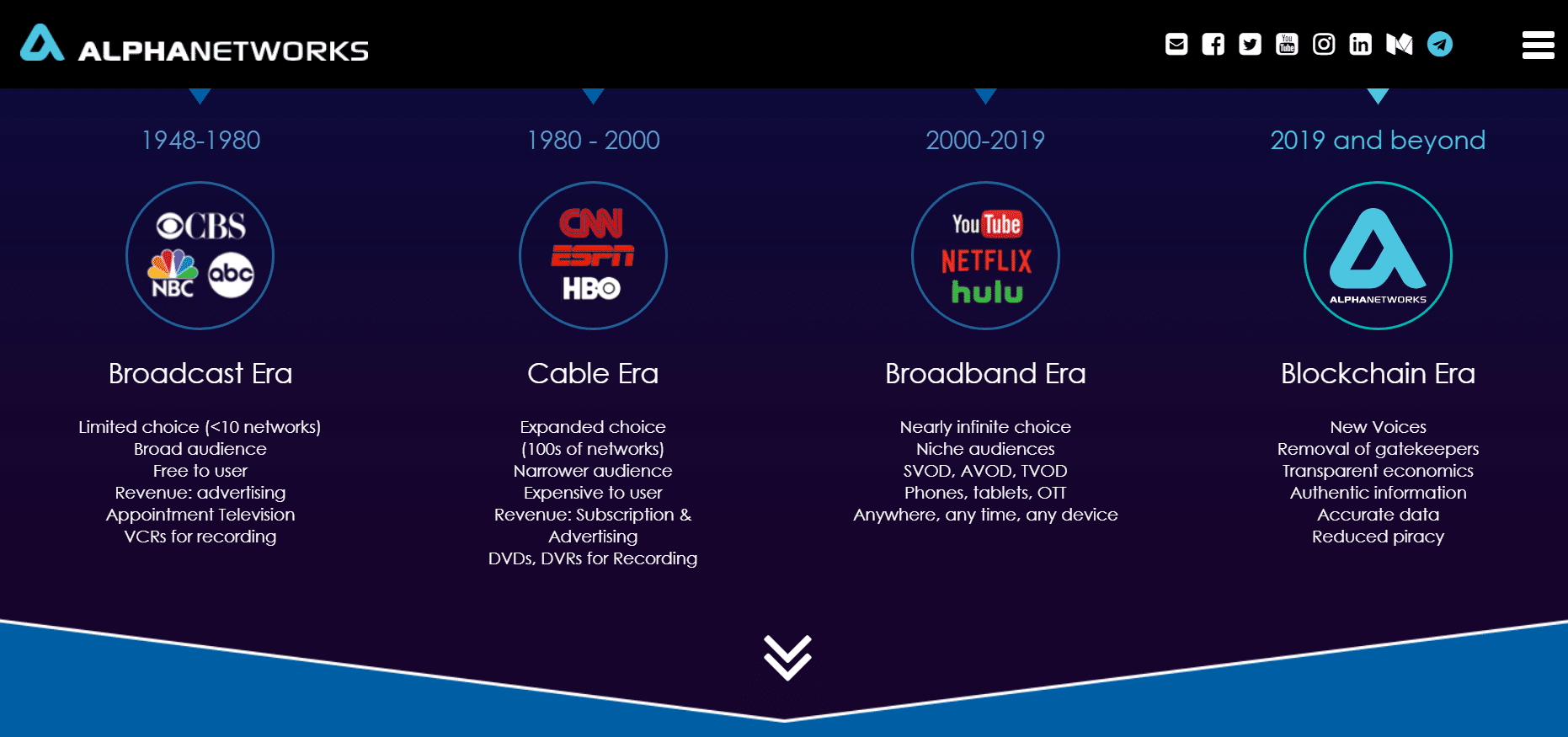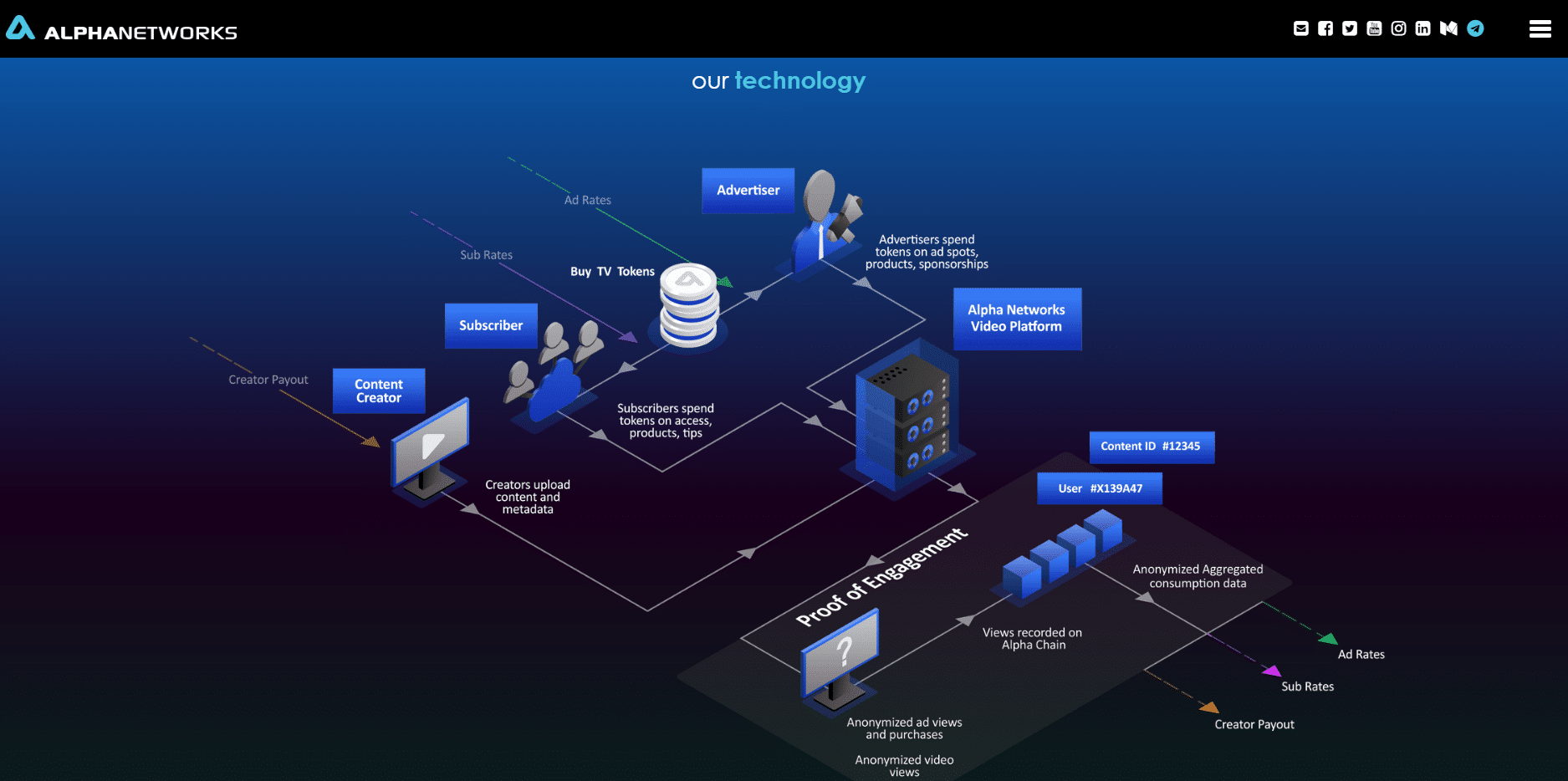Latest news about Bitcoin and all cryptocurrencies. Your daily crypto news habit.
Another day, another blockchain company resolved to take on the broken media and advertising industries.
It’s a pretty common assumption that current models are failing on many fronts. Viewers are forced to watch ads they have no interest in. Advertisers pay to irritate the wrong audience. As for the content creators? They’re mostly scraping by on cup-noodles in dimly-light apartments.
“That’s how I would define broken,” says Seth Shapiro Founder of media company AlphaNetworks. “Things are broken when the creator isn’t really happy, and the consumer isn’t really happy and no one feels like they got a great deal. They’re all just trying to get by and I think we can do a lot better.”
So what makes AlphaNetworks any different from all the other starry-eyed blockchain-powered media crusaders out there? A working product, for starters. A solid team with media, blockchain, and technology backgrounds. And some pretty serious partners that include the likes of IBM Cloud Video, Watson AI, and RadicalMedia.
CoinCentral caught up with Seth at the World Blockchain Forum in London this month to find out how he and his team intend to fix the media’s woes.

Seth Shapiro Founder AlphaNetworks
How Did Seth Shapiro Get into Blockchain?
With a background in psychology and a passion for music, Seth worked as a producer of an independent record label, learning two valuable lessons early on. First, that organizational psychology is fundamental to success. “So much of innovation has to do with the culture of the company,” he says. And second, “never go into a business that’s not expanding.”
He sighs, “I love music, but the music business faces fundamental challenges that the people who run it have never really fully addressed.”
Wait, so, the media industry’s always been broken? Shapiro thinks that it has. As a two-time Emmy Award winner, who’s worked as a Senior Producer for Walt Disney Company and Head of Production at DIRECTV, he’s had front row seats for its evolution.
“I’ve always been the guy doing the new thing, so I’ve always been hired as somebody who worked on whatever the new platform with the new technology was.”
A quick glance at Shapiro’s LinkedIn profile is enough to make your head spin. From music composition to software engineering, media, and technology, he’s presided over many a wave of innovation. He also learned to code.
“After I was in music, I decided never to be in a business that wasn’t growing. The thing that was growing was digital. I made this big intuitive leap and decided that I was going to learn to be a coder. The only way to understand and how to get into the business at the time really was to be able to do it myself.
I moved to Hollywood right as the Internet was starting. There were maybe five producers in Hollywood who were actually competent producers who could also manage software development. I was one of them, so that was really good timing.”
Media and Technology Are Closely Intertwined
“I think fundamentally that the media business is always tied to technology. Most of the major economic moves and most of the major creative moves in media happen by the harnessing of new technology with something really creative. You’ll wind up with a new technology and then this sort of cultural renaissance, and then it will slow down and get boring, and then another technology will open it up again.

Blockchain is the Fourth Wave of Media https://alphanetworks.io/
I think now we’ve got a series of business models that are aging completely out of usefulness. As an example, television news. Television news started really with Kennedy. Kennedy made the news sexy. That’s when the news went from 15 minutes to 30 minutes. That’s when people started hiring international bureaus. It peaked probably with Watergate and the Vietnam War… Now, TV news is for people in their sixties.”
The stats on cable TV, in general, are pretty glum, with viewers cutting the cord in droves. The average home pays for 206 networks and watches about 15, and the average TV news viewer is 68 years old. But what about YouTube, Netflix, and live streaming?
Social Media Is Not the Solution
“I think in many fundamental ways, YouTube is broken,” he says. “There was a lot of promise in the idea of broadcast yourself or the influencer-driven age. But the fact is that we’re in an environment where anybody’s content can be pulled down off of a platform at any time for any reason. And only 3 percent of all the total contributors earn above the poverty line. That to me seems like it’s not an optimal model.
As influencer culture becomes more and more important and as more people have the ability and the talent to make good videos, there ought to be a way for them to make a living. It’s not just YouTube, it’s Facebook as well. I think that trying to build a video-based business or trying to build a business on YouTube or Facebook is like trying to build a house on somebody else’s land. You’re just waiting for the other shoe to fall.”

YouTube Content Removed
And what about the problem of fake news? “Fake news, yes. Lack of authentication, lack of traceability. Another [industry] that’s broken, now you got me started, is advertising. Advertisers are engaging in what I would consider a guaranteed failure system because they’re paying for something that people fundamentally dislike.
What kind of sense does that make? You’re paying to force me to watch something that I just do not want to see. The solution was supposed to be online, but YouTube is even worse. Preroll is just as annoying. They manage to fit as much annoyance into 15 seconds as it took TV to do in 30.”
The Problem for Content Creators
“The existing models still have a lot of problems. I wouldn’t say they’re broken but they’re not optimal. For example, Netflix takes an exclusive, often 10-year license for a piece of content. They pay a certain amount, but then the rights holder has very little freedom. That content is basically gone. They get almost no data back from Netflix. Even though Netflix can collect an extraordinary amount of data, they actually don’t share it with the content creator.”
This means that show producers have no idea who is watching their shows, the popularity of certain episodes, what demographics they’re appealing to most, what kind of topics to avoid and which topics catch viewers’ attention. “You would have thought the idea that digital would be more transparent and give more and more data. That’s actually not the case yet,” he says.
The issue of piracy is also a “massive problem,” he says. “There’s more content online, but now anybody, anywhere in the signal chain from an actor to a producer to a director to a studio who makes a feature film lives in mortal terror that the movie is going to wind up on BitTorrent before the opening weekend and destroy hundreds… I’ve been with producers whose movies leaked and it’s like going to a funeral.”
The AlphaNetworks Solution
“What we’re doing with AlphaNetworks is taking a world-class streaming video solution that’s already built and we’re pairing that with our own in-house blockchain system for recording every interaction by every consumer with every piece of content. We will have an exact record of exact consumption. Then we share that in a really powerful dashboard back with every creator.

The AlphaNetworks Solution
Our algorithm is called Proof of Engagement and so what it does is it’ll actually tell your episode seven hit it out of the park. We see you have a trending audience in South America. Your episodes that deal with recipes are extremely successful… Then we pay based on actual consumption. It’s all written to the chain and if you got 237,000 views, you get paid for 237,000 views.”
And unlike Netflix who is reluctant to share data with content creators, AlphaNetworks wants content creators to succeed. “The more people want to watch you, the more network effect there is in more people wanting to come into our world and consume more content. So we’re totally aligned with [the content creator]. We want you to make as much money as possible and we want to be a happy place for content creators.”
The Problem for Viewers and Advertisers
“The number one most powerful media business model of all time to date is subscription TV. Pay TV, for decades, just generated billions of billions of dollars,” Seth says. “It doesn’t work anymore. The thing that works now and that is going to work increasingly is streaming video services. People paying smaller amounts of subscriptions for more of the stuff that they want and paying less for stuff that they have absolutely no interest in.”
Moreover, viewers are slapped with advertising each time they switch on. “You shouldn’t punish people with advertising and frankly, that’s no good for the advertiser either. It just creates a negative association. One thing we’ll do is we’ll just pay people to watch ads. Another thing we’ll do is we’ll target the ads more effectively to the customer.”
The AlphaNetworks Solution
“Part of the token economy that we’ve designed is for the way that the media business really works. If people watch advertising, they either opt-in or get paid to do it or have some sort of genuine utility… If we know that you’re a crypto person, then a good piece of advertorial on comparing different cold wallets might not be annoying to you. It might be actually worthwhile to you, but it’s also worthwhile to Ledger or Trezor if it gets you to buy one. I think that we want to innovate new forms of content that are informational advertising that isn’t a waste of time.
You’re satisfying the advertiser because they’re getting to tell them a lot more information. But you’re not wasting the time of the people who aren’t interested. Those are the kind of things that we want to do. Create advertising that is more pleasurable and useful and not annoying.”
There will also be branded content, like the old-fashioned soap operas with content brought to you by certain labels. No need to watch an advert but the advertisers get to align themselves with a cool show, and the consumer has a favorable image of the brand. “Advertisers need to be in the business of giving consumers value back,” he says.
A Few More Cool Things That Make AlphaNetworks Stand Out
Apart from a working product and some pretty insane partnerships, the company is thinking way into the future. Through Watson AI, they can actually extract facial and auditory recognition and learn the types of content viewers enjoy the most to target highlights to them. Creepy or cool?
“Watson has full visual recognition and full auditory recognition and can begin to extract metadata and subject matter and tonality and sentiment,” Seth says. They already tried it out editing high-quality football reels.
“We’re looking to really deepen the metadata and the information about programming and to do deeper data analysis on what people are really responding to and then to be able to more effectively get them more stuff that they really like without having to wade through thousands and thousands of stuff. If you consider an environment like YouTube, if you’re not searching for a particular artist, it can be very challenging to find something. You need a much deeper curation and data science approach.”
And What About IoT?
Seth’s face lights up. “Nobody’s brought this up in a while,” he says, “but yes, on the IoT front, one of the other reasons why I’m so excited about AlphaNetworks and why I think this whole area is going to be so explosive is to exactly your point. Video consumption, as soon as things like self-driving cars proliferate, basically people are going to have hours and hours more screen time.
There’s going to be nothing else to do. You’re going to see the proliferation of more and more what we used to think of as screens and then eventually our kids will be like, ‘Oh, that was so cute! They used to watch these devices. How old-fashioned.’ It’ll just be out here in your field of vision with augmented reality and stuff.
There’s going to be a larger and larger audience for more, I don’t want to call it niche, but more types and areas of programming that haven’t even been invented yet.”
Final Thoughts
Contemplating wandering around in a personalized, driverless bubble, watching content and advertising collide with the real world, it’s hard to imagine having any contact with our kids at all. But then, throughout out the ages technology has been brandished as detrimental to society. Perhaps if we have an ecosystem in which all stakeholders are happy and the value flows in the right direction, we may be able to reconcile with technology after all.
Disclaimer
The views and opinions expressed in this article are solely those of the authors and do not reflect the views of Bitcoin Insider. Every investment and trading move involves risk - this is especially true for cryptocurrencies given their volatility. We strongly advise our readers to conduct their own research when making a decision.